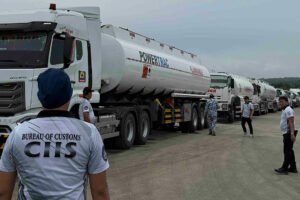The Bureau of Customs (BoC) is holding the line on its PHP 958.7-billion revenue goal for 2025 despite a sharp drop in imports and fewer working days in October that slowed collections, a stance that keeps pressure on the agency as the government grapples with weaker fiscal inflows.
Customs Commissioner Ariel F. Nepomuceno said the bureau is not giving up on the full-year target even after the total volume of imports fell by 3% or about P80 billion last month, denting duties and taxes.
“I don’t want to give up because we’re already at 98% efficiency,” he told reporters on the sidelines of a Senate plenary debate on the 2026 budget on Nov. 17. “We can still do it if we can in November [and] December.”
The BoC collects taxes and duties from all goods imported to the Philippines.
The Department of Finance earlier warned that Customs, one of the country’s revenue-generating agencies, may miss its full-year targets this year amid slower global trade due to US President Donald J. Trump’s tariff policies.
“We could have hit the target this October if there had been one more working day. Compared to last year, there were more working days… due to the storms,” he said.
The Philippines was battered by back‑to‑back storms, including typhoons Tino and Uwan, which shut businesses, ravaged cities and forced class suspensions in October.
The latest data from the Treasury showed that Customs revenue collection inched up by 1.59% to PHP 701.7 billion in the first nine months, accounting for 73.12% of the full-year target.
Customs has yet to release a breakdown of its October collections.
Despite this, Mr. Nepomuceno said Customs is banking on petroleum imports to help offset weaker revenues as the extension of the rice import ban and slower trade weigh on collections.
“But we’re trying to check if there are other sources that can compensate (for the slower revenues). Like petroleum products, probably we can generate more revenues from that, given that the ban for rice importation has been extended,” he said.
Mr. Nepomuceno warned that foregone revenues from the rice import freeze, expected to last until mid-January, could reach over PHP 6 billion.
He also noted that Customs seized PHP 3.6 billion worth of smuggled goods between July and September.
“The new team accounted for about 50% of total apprehensions in just 90 days. So, there is a sense of hope that we can improve further until we fully digitalize,” he said.
Customs earlier reported the BoC is also looking to enter into a public and private partnership to fully digitalize its operations.
Rizal Commercial Banking Corp. Chief Economist Michael L. Ricafort said the BoC can still meet its PHP 958.7‑billion revenue goal for 2025 if import volumes rebound.
“Imports could increase as more exporting countries diversify exports away from the US and more for countries like the Philippines amid Trump’s higher tariffs, trade wars, and protectionist policies,” he said in a Viber message. — Aubrey Rose A. Inosante, Reporter







 DOWNLOAD
DOWNLOAD















